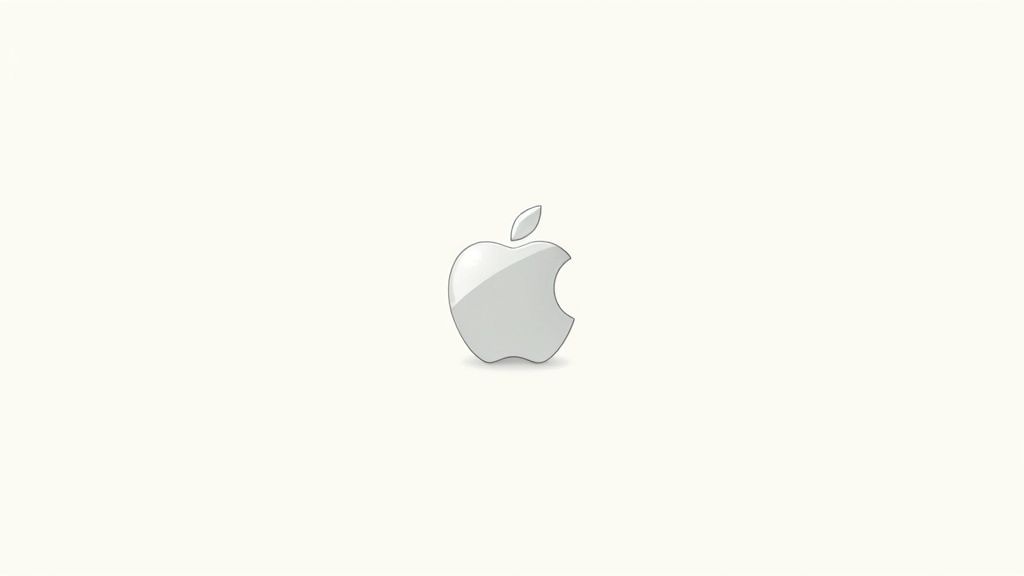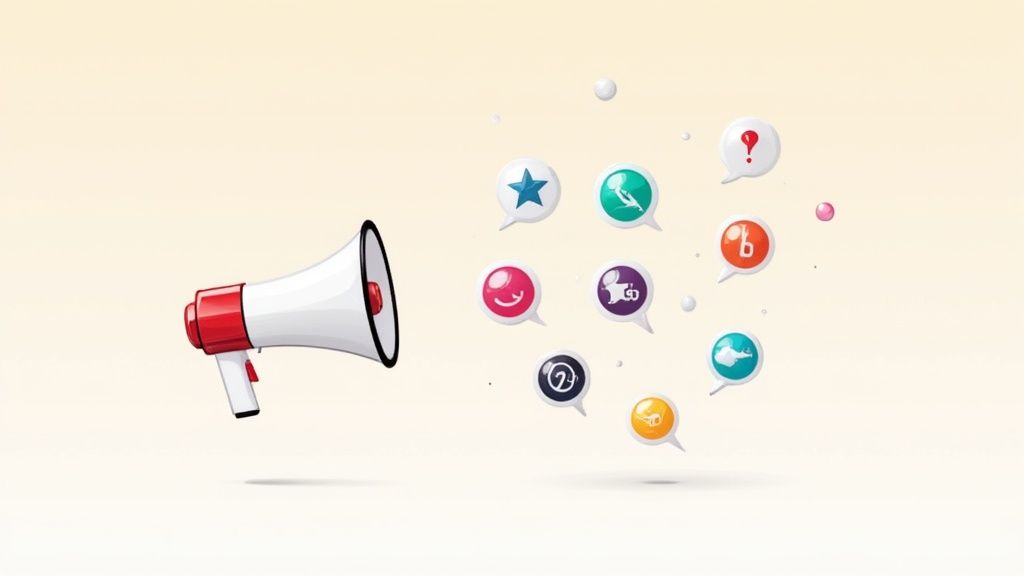Discover the Power of a Unique Brand Voice
Want to stand out and connect deeply with your audience? This listicle showcases eight powerful brand voice examples to inspire you. Discover how brands like Mailchimp, Apple, and Nike use their unique voices to build lasting connections. Learn from these real-world brand voice examples and craft a compelling voice that resonates with your ideal clients, fuels your business growth, and sets you apart in 2025.
1. Mailchimp's Playful and Witty Voice
Looking for a brand voice that's both professional and playful? Mailchimp offers a prime example of how to strike this delicate balance. They've mastered the art of approachable, conversational communication, often injecting humor without ever undermining their expertise in email marketing. This unique voice simplifies complex marketing concepts, making them digestible for everyone, while simultaneously making the brand memorable and distinctive in a crowded market. This approach is a game-changer for building a strong brand identity, especially for solopreneurs, aspiring creators, and career pivoters looking to stand out.

Mailchimp's success lies in its distinct features: a playful and witty tone, conversational language, simple explanations of complex topics, a consistent voice across all platforms, and the strategic use of humor without sacrificing clarity. These elements work together to create a cohesive and engaging brand experience. Imagine effortlessly explaining email segmentation to a client with a touch of humor, just like Mailchimp. This approachable communication style builds trust and rapport, making even the most technical aspects of marketing feel less daunting.
This approach offers numerous advantages. It creates strong brand recognition – who can forget Freddie the Chimp? It also makes technical topics accessible, building an emotional connection with users and differentiating Mailchimp from competitors. This resonates particularly well with creative professionals and those seeking a more human touch in their marketing tools. Learn more about Mailchimp's Playful and Witty Voice to delve deeper into their brand strategy.
Of course, no approach is without its potential drawbacks. Mailchimp’s playful voice may not resonate with extremely corporate audiences, and humor, even when well-intentioned, can occasionally miss the mark. Maintaining this consistent level of wit and charm requires skilled writers dedicated to upholding the brand voice guidelines.
Examples of Mailchimp’s effective voice include their famous 'high five' success messages, the personality extensions of Freddie the chimp mascot, and even their playful 404 error pages. Their style guide explicitly states: "We're informal, but not sloppy," a principle that perfectly encapsulates their approach. This attention to detail, combined with consistent messaging across channels from social media to in-app notifications, has contributed to their widespread brand recognition, further amplified by the viral "Mail-Kimp" mispronunciation from the Serial podcast.
So, how can you capture some of Mailchimp’s magic for your own brand? Start by developing clear voice guidelines for all your content creators. Strive to balance humor with helpfulness, using conversational language while maintaining professionalism. Crucially, test your voice with your target audience to ensure it resonates. Remember, consistency is key – maintain your chosen voice across all channels. This approach is especially powerful for coaches, consultants, and purpose-driven professionals looking to attract the right clients and infuse their brand with personality. By embracing a playful yet professional voice, you can connect with your audience on a deeper level, building a brand that is both memorable and impactful.
2. Apple's Minimalist and Confident Voice
Apple has mastered the art of saying more with less. Their brand voice, a cornerstone of their global success, is a prime example of minimalist and confident communication. It's about stripping away complexity and focusing on the core essence of what their products offer – a seamless and enriching user experience. This approach works by connecting with users on an emotional level, highlighting the benefits and lifestyle improvements their products provide, rather than getting bogged down in technical jargon.

Apple's communication is characterized by short, declarative sentences that exude confidence and authority. Think of iconic phrases like "Think Different" or the simple elegance of product names like "iPad" and "iPhone." This minimalist language reflects their sleek product design and reinforces their image as innovators who simplify technology for everyone. This brand voice resonates particularly well with today's consumer, who values simplicity and ease of use. For solopreneurs, aspiring creators, career pivoters, coaches, consultants, and purpose-driven professionals alike, Apple's approach offers invaluable lessons in crafting a compelling brand identity.
Features of Apple's Brand Voice:
- Minimalist language: Eliminating unnecessary words for maximum impact.
- Short, declarative sentences: Conveying information clearly and confidently.
- Focus on benefits, not specs: Highlighting how products improve users' lives.
- Confident, authoritative tone: Positioning Apple as a leader in innovation.
- Emotional appeals tied to lifestyle: Connecting products to user aspirations and identity.
Pros:
- Creates perception of simplicity and accessibility: Makes technology less intimidating.
- Establishes authority and expertise: Positions Apple as a trusted source.
- Emotionally connects products to user identity: Fosters brand loyalty.
- Consistent with product design: Creates a unified brand experience.
- Differentiates from feature-focused competitors: Cuts through the noise.
Cons:
- Can sometimes be perceived as arrogant: The confidence can alienate some.
- Limited technical detail for power users: May not satisfy those seeking in-depth information.
- May feel repetitive or formulaic over time: Requires ongoing creativity to maintain freshness.
Examples of Apple's Brand Voice in Action:
- "Think Different" campaign: A powerful statement of Apple's philosophy.
- "It just works" philosophy: Underscores the seamless user experience.
- Product descriptions like "Magical" and "Revolutionary": Evokes excitement and wonder.
- Keynote presentations with phrases like "Our best iPhone ever": Reinforces leadership and innovation.
- Simple product names (iPad, iPhone): Easy to remember and pronounce.
Tips for Implementing Apple's Approach:
- Focus on benefits over technical specifications: Highlight the "why" behind the product.
- Eliminate unnecessary words: Strive for clarity and conciseness.
- Create emotional connections to products: Show how your offering improves lives.
- Use confident, declarative statements: Project authority and expertise.
- Maintain consistency between product design and messaging: Create a cohesive brand experience.
Individuals seeking to refine their brand voice can learn valuable insights from Apple's strategy. Learn more about Apple's Minimalist and Confident Voice and discover how to apply these principles to create a compelling and resonant brand identity. By focusing on the user experience and communicating with clarity and confidence, you can differentiate your brand and build a loyal following. This method deserves a place on this list because it showcases the power of simplicity and emotional connection in building a world-renowned brand. Those seeking to elevate their brand messaging, whether they are solopreneurs launching a new service or established coaches looking to refine their appeal, can draw immense inspiration from Apple's minimalist yet powerful approach.
3. Nike's Motivational and Empowering Voice
Nike's brand voice is a prime example of how to connect with your audience on a deeply emotional level. It's more than just selling shoes and sportswear; it's about tapping into the inherent drive within each of us to push our limits and achieve our personal best. This voice resonates powerfully with those who strive for greatness, regardless of their athletic abilities. It's about embracing the journey, celebrating the victories, and learning from the setbacks. This carefully cultivated voice has transformed Nike from a sportswear company into a global symbol of motivation and self-belief.

This approach works by framing athletic pursuits not as a specialized activity, but as a universal human experience. By using direct, inspirational language and focusing on overcoming obstacles, Nike creates a sense of camaraderie and shared purpose. This powerful brand voice example resonates particularly well with solopreneurs building service businesses, aspiring creators crafting content, career pivoters seeking new direction, coaches and consultants looking to attract the right clients, and purpose-driven professionals yearning for deeper meaning. It inspires them to take action, overcome challenges, and ultimately, achieve their own definition of success.
Nike's success stems from several key features: a motivational and inspirational tone, direct and commanding language, an inclusive definition of "athlete," emotionally charged messaging, and a celebration of human potential. This results in a powerful emotional connection with customers, motivating them to action and transcending sports categories to appeal across cultural boundaries. Nike positions itself not just as a seller of athletic gear, but as an enabler of personal achievement. Consider their iconic "Just Do It" campaign or the empowering "Find Your Greatness" messaging. These slogans aren't just about sports; they're about life. Learn more about Nike's Motivational and Empowering Voice for a deeper dive into their compelling storytelling.
However, this approach has its potential drawbacks. The highly motivational tone can sometimes feel generic or clichéd, especially if not backed up by genuine, consistent actions. The high emotional intensity can also be difficult to maintain across all communication channels. Authenticity is crucial.
Actionable Tips for Incorporating Nike’s Approach:
- Use Active, Decisive Language: Employ strong verbs and avoid passive voice to convey confidence and inspire action.
- Create Emotional Narratives: Weave stories of transformation and overcoming challenges around your products or services.
- Celebrate Customer Achievements: Highlight your audience's successes to foster a sense of community and shared progress.
- Keep Messages Brief and Impactful: Short, memorable phrases can have a lasting impact. Think "Just Do It."
- Connect Products/Services to Personal Transformation: Position your offerings as tools that empower individuals to reach their full potential.
Nike’s motivational and empowering voice, popularized by figures like Phil Knight, Dan Wieden (the creative mind behind "Just Do It"), and iconic athletes like Michael Jordan, Serena Williams, and LeBron James, deserves its place on this list of brand voice examples because it demonstrates the immense power of connecting with your audience on an emotional level. By tapping into universal desires for achievement and self-improvement, Nike has built a brand that resonates far beyond the world of sports, inspiring individuals across all walks of life to pursue their own greatness. This is a powerful model for any brand aiming to build a loyal following and make a meaningful impact.
4. Wendy's Sassy and Irreverent Voice
Looking for a brand voice that truly pops and resonates with a younger audience? Wendy's provides a powerful brand voice example, demonstrating how a dash of sass and a whole lot of irreverence can transform a brand from fast-food staple to cultural icon. This approach isn't about being mean-spirited; it's about being authentic, engaging, and unafraid to break the mold of traditional corporate communication. By embracing humor, quick wit, and a healthy dose of playful roasting, Wendy's has cultivated a unique personality that cuts through the noise and fosters genuine connections. This distinct brand voice is particularly evident on social media, where they engage in witty banter with customers and competitors alike.

Wendy's success lies in its ability to leverage several key features: a sassy, irreverent tone; pop culture references that resonate with their target audience; direct callouts of competitors (often in jest); conversational language that feels relatable; quick-witted responses that keep the conversation flowing; and a strategic use of humor that entertains and engages. These elements combine to create a brand voice that feels undeniably human, a breath of fresh air in a world of often sterile corporate messaging.
This approach has yielded impressive results, including viral social media moments like the #NuggsForCarter campaign and National Roast Day participation, generating free publicity and strengthening brand recognition. It differentiates Wendy's from its corporate-sounding competitors and builds authentic connections, especially with younger audiences who appreciate the brand's playful personality. Think about how this could translate to your brand. Imagine the possibilities for solopreneurs, aspiring creators, or career pivoters looking to establish a unique identity. For coaches and consultants, this approach could be the key to attracting the right clients who value authenticity and a fresh perspective. Even purpose-driven professionals can benefit from injecting a touch of personality into their brand, making their message more relatable and engaging.
Of course, this approach isn't without its potential drawbacks. There's a risk of controversy or backlash if humor misses the mark or is perceived as offensive. It may alienate more conservative or older customers who don't appreciate the irreverent tone. This type of brand voice also requires constant vigilance and quick thinking to stay relevant and engaging. Finally, the focus on humor and sass may overshadow important product quality messaging.
Here are some actionable tips to help you incorporate this brand voice example effectively:
- Establish clear boundaries: Define what constitutes "sass" versus meanness to avoid crossing the line.
- Be responsive: Engage with cultural moments and trends quickly to stay relevant and top-of-mind.
- Maintain authenticity: Ensure your sassy voice remains consistent across all platforms.
- Streamline approvals: Develop approval processes that don't stifle your ability to respond quickly.
- Know your audience: Understand when to be serious and when to be playful.
Wendy's success is a testament to the power of a well-crafted brand voice. By embracing authenticity, humor, and a willingness to take risks, Wendy's has carved out a unique space in the competitive fast-food landscape. This brand voice example offers invaluable lessons for anyone looking to create a brand that resonates, engages, and leaves a lasting impression. Consider how this approach can help you differentiate your brand, build stronger connections, and ultimately achieve your business goals. While Wendy's doesn't specifically highlight their brand voice on their website, their social media channels (like Twitter) offer a masterclass in how to execute this strategy effectively.
5. Dove's Authentic and Empathetic Voice
Are you a solopreneur, aspiring creator, or career pivoter struggling to connect with your audience on a deeper level? Perhaps you're a coach, consultant, or purpose-driven professional seeking a brand voice that resonates with authenticity and inspires action. Look no further than Dove's brand voice as a shining example of how to build a powerful connection with your audience. This is a prime brand voice example because it showcases the power of values-driven marketing. Dove masterfully demonstrates how aligning your brand with a social purpose can not only differentiate you but also foster deep loyalty and trust.
Dove has cultivated a brand voice centered on authenticity, empathy, and challenging conventional beauty standards. Rather than simply selling soap, they're fostering a movement. Their communication is thoughtful, inclusive, and aimed at building women's self-esteem and confidence. This approach moves beyond transactional marketing and creates a community around shared values.
How it Works:
Dove's approach hinges on several key features: an empathetic and supportive tone, a focus on real stories and real people (not just airbrushed models), a bold challenging of industry norms, inclusive language that celebrates all bodies, and an educational approach to beauty standards that empowers consumers. Through campaigns like the groundbreaking "Real Beauty" campaign, the impactful "Self-Esteem Project," and the thought-provoking "Real Beauty Sketches" video, Dove positions itself as an advocate for realistic portrayals of women and self-acceptance. More recently, the #ShowUs campaign further solidified their commitment to diverse beauty. Even their product messaging reflects this body-positive ethos. This consistent messaging across all touchpoints is key to their success.
Why This Approach Works:
- Creates deep emotional connections: By speaking to the insecurities and aspirations of real women, Dove fosters genuine connection and trust.
- Differentiates from traditional beauty marketing: In a crowded market saturated with unrealistic ideals, Dove's authentic voice stands out.
- Builds long-term brand loyalty: Consumers are more likely to stick with a brand that shares their values and makes them feel good about themselves.
- Appeals across demographic groups: The message of self-acceptance resonates with a diverse audience.
- Positions brand as socially responsible: Dove's commitment to positive social impact enhances their brand image and attracts conscious consumers.
Pros and Cons:
While Dove's approach offers numerous advantages, it's important to acknowledge the potential challenges:
- High ethical standards: Maintaining authenticity requires consistent action and alignment with stated values. Any deviation can damage brand trust.
- Scrutiny of parent company: Dove, owned by Unilever, faces scrutiny based on the actions of other brands within the portfolio.
- Balancing commercial interests with social messaging: Finding the right balance between selling products and promoting social good is crucial.
- Risk of appearing inauthentic: Any hint of insincerity can backfire and erode consumer trust.
Actionable Tips for Your Brand:
- Feature real customers: Showcase the diversity of your audience and build relatability.
- Use inclusive language: Be mindful of the language you use and ensure it celebrates all bodies and identities.
- Back messaging with concrete social initiatives: Demonstrate your commitment through tangible action.
- Create content that educates and empowers: Provide value beyond product promotion.
- Be consistent across all touchpoints: Ensure your brand voice is consistent across your website, social media, advertising, and customer service.
Examples of Successful Implementation: The Real Beauty campaign, Self-Esteem Project, Real Beauty Sketches video, and the #ShowUs campaign all serve as powerful examples of Dove's authentic and empathetic voice in action.
Learn more about Dove's Authentic and Empathetic Voice
Dove's long-term commitment to the Real Beauty platform, spearheaded by individuals like Global Creative Director Kathy O'Brien and supported by initiatives like the Unilever Sustainable Living Plan, demonstrates the power of a consistent and purpose-driven brand voice. By focusing on genuine connection and social impact, Dove provides a compelling brand voice example for any business looking to create a meaningful and lasting impact.
6. Dollar Shave Club's Irreverent and Direct Voice
Finding your unique brand voice can be a game-changer, especially when you're competing in a crowded market. Dollar Shave Club’s success story is a prime example of how a distinctive brand voice can catapult a business to success. This is a perfect brand voice example for solopreneurs, aspiring creators, career pivoters, coaches, consultants, and purpose-driven professionals seeking to differentiate themselves and connect authentically with their target audience.
Dollar Shave Club disrupted the men’s grooming industry not just with its subscription model but with its refreshingly irreverent and direct voice. This brand voice example demonstrates the power of speaking directly to your customer, cutting through the noise of traditional marketing with humor and authenticity. Their communication avoids marketing jargon, opting instead for blunt humor, conversational language, and a straight-talking approach that resonates with everyday men. This positioned them as the relatable, no-nonsense alternative to the overly-serious, traditional razor brands. The result? A fiercely loyal customer base and a brand identity that stands out from the crowd.
Features of Dollar Shave Club’s Brand Voice:
- Conversational, "man-to-man" tone: Think of chatting with a friend at the bar – casual, relatable, and engaging.
- Irreverent humor: They're not afraid to poke fun at themselves or the industry, making their message memorable and shareable.
- Direct, no-nonsense messaging: They get straight to the point, addressing customer pain points head-on.
- Casual language with occasional profanity (used strategically): This adds to the authentic and unfiltered feel, further differentiating them from polished corporate competitors.
- Problem-solution focused communication: They clearly articulate the problem (expensive razors) and offer a simple solution (affordable, high-quality blades delivered to your door).
Pros:
- Creates instant differentiation: Their voice stands in stark contrast to traditional, often stuffy, competitors.
- Resonates with men tired of traditional marketing: It feels genuine and avoids the usual marketing tropes.
- Makes grooming products approachable: A topic that can be mundane becomes engaging and even entertaining.
- Builds authentic connection: Customers feel like they're part of an inside joke.
- Simplifies purchasing decisions: By focusing on the core problem and solution, they eliminate confusion and streamline the buying process.
Cons:
- Humor can sometimes miss the mark: Not every joke lands, and there's a risk of alienating some potential customers.
- Not appropriate for all audiences: The irreverent tone and occasional profanity limit their appeal in certain markets.
- Can limit expansion to more premium markets: The casual approach may not translate effectively to luxury branding.
- Challenging to maintain authenticity after corporate acquisition: (Dollar Shave Club was acquired by Unilever) Balancing the original voice with corporate guidelines can be tricky.
Examples:
- Our Blades Are Fing Great viral launch video:* This video perfectly encapsulates their irreverent humor and direct approach. ([Link to video if available])
- Email marketing with subject lines like "Hey, it's us again": This maintains the casual, conversational tone even in marketing communications.
- Bathroom reading material "Bathroom Minutes": This quirky content extends the brand experience beyond the product itself.
- Product descriptions focusing on solving real problems: They emphasize the benefits and address customer needs directly.
- Mike the founder's direct camera address style: This further personalizes the brand and strengthens the connection with customers.
Tips for Implementing a Similar Voice:
- Speak like your customer speaks: Understand their language, their humor, and their pain points.
- Address pain points directly: Don't shy away from the problems your product or service solves.
- Don't be afraid to be imperfect: Authenticity is key. Embrace your quirks and imperfections.
- Use humor (appropriately) to discuss otherwise boring products or services: Humor can make your message memorable and engaging.
- Create consistent voice across all acquisition touchpoints: From your website to your social media, ensure your voice is consistent.
Popularized By: Founder Michael Dubin, the viral launch video that generated millions of views, and Chief Creative Officer Rich Quan.
Dollar Shave Club's brand voice is a compelling brand voice example because it demonstrates that being different and authentic can be a powerful differentiator. By daring to be bold and break the mold, they carved a unique space for themselves and built a loyal following. This approach can be incredibly inspiring for anyone building a brand from scratch, proving that you don’t need a massive budget to make a big impact. You need a clear voice and the courage to use it.
7. Innocent Drinks' Friendly and Conversational Voice
Innocent Drinks has cracked the code on making a commodity product—smoothies and juices—feel remarkably personal. They've achieved this through a distinctively friendly, playful, and conversational brand voice, a prime example of how a strong voice can transform a brand. This approach makes consumers feel like they're chatting with a friend rather than being subjected to marketing, making it a powerful brand voice example for any aspiring entrepreneur or creator. This friendly approach humanizes their brand and builds strong emotional connections, a critical ingredient for success in today's crowded market.
This voice is built upon several key features: a conversational, friendly tone; a sense of childlike enthusiasm and wonder; simple, accessible language; a healthy dose of self-deprecating humor; and a storytelling approach to their ingredients, often personifying the fruits and vegetables. Think of it as a charmingly naive friend excited to share their latest delicious discovery.
Why does this approach work so well?
- Creates strong brand differentiation: In a market flooded with smoothie and juice options, Innocent's voice helps them stand out. They're not just selling a drink; they're selling an experience.
- Makes healthy products approachable and fun: Health foods can sometimes feel preachy or intimidating. Innocent's lighthearted approach makes healthy choices feel enjoyable.
- Builds emotional connection: This voice goes beyond product attributes and fosters genuine connection, building brand loyalty that transcends mere transactions.
- Appeals to a broad audience: The playful yet genuine nature of the voice resonates with both children and adults.
- Memorable packaging and marketing: From quirky copy on bottle bases like "Stop looking at my bottom" to their annual "Big Knit" campaign featuring tiny knitted hats on bottles, their voice makes their products instantly recognizable.
Pros and Cons:
While highly effective, this voice isn't without its potential drawbacks:
- Too cute or precious: For some demographics, the overly playful tone might feel forced or inauthentic.
- Difficulty with serious topics: This voice doesn't lend itself well to addressing serious issues or crises.
- Maintaining consistency post-acquisition: After being acquired by Coca-Cola, maintaining this unique voice has been a challenge.
- Cultural translation: This light-hearted approach might not resonate in all markets or demographics.
Examples in Action:
- Straightforward positioning: "We make tasty drinks" – simple, honest, and effective.
- Quirky packaging: The playful copy on their bottles adds a touch of delight to the everyday.
- The Big Knit: This annual campaign is a perfect example of their playful personality and commitment to social good.
- Social media: Their posts often humanize fruits and vegetables, creating engaging and shareable content.
- Email marketing: They use a conversational tone that makes emails feel personal and engaging.
Tips for Implementing a Similar Voice:
- Write like you speak: Imagine you're chatting with a friend. Keep it natural and authentic.
- Read your copy aloud: This helps you catch any awkward phrasing and ensure a conversational flow.
- Inject small moments of delight: Surprise and delight your audience with unexpected touches of humor or whimsy.
- Maintain consistency: Ensure your voice is consistent across all platforms, from packaging to social media.
- Embrace imperfections: Allow your personality to shine through carefully chosen imperfections. It adds to the authenticity.
For solopreneurs building a service business, aspiring creators trying to find their online voice, career pivoters seeking a fresh start, coaches and consultants looking to attract the right clients, and purpose-driven professionals craving more meaning, Innocent's approach provides valuable lessons. It shows how a distinct voice can cut through the noise, build a strong brand identity, and forge genuine connections with your audience. Learn more about Innocent Drinks' Friendly and Conversational Voice to understand how audience insights can help you craft a voice that truly resonates. By understanding your audience and injecting personality into your brand, you can create a memorable and impactful presence in the marketplace. Innocent Drinks proves that even in a crowded market, a friendly voice can be a powerful differentiator. This is why it deserves a place in this list of brand voice examples.
8. IKEA's Practical and Clever Voice
Finding your brand voice can feel like assembling flat-pack furniture without instructions. Overwhelming, right? But look at IKEA—they’ve mastered the art of clear, concise, and charming communication, turning even the most daunting assembly project into a manageable (and sometimes even enjoyable) task. Their practical and clever brand voice is a prime example of how to connect with your audience authentically, and it deserves a spot on this list for its global impact and consistent application. This approach is particularly inspiring for solopreneurs, aspiring creators, and career pivoters seeking to build a distinct brand identity.
IKEA's voice embodies the very essence of Scandinavian design: functional, straightforward, and subtly clever. It's built upon the foundation of democratic design, making home furnishing accessible to everyone through clear, solution-oriented language. This resonates powerfully with their target audience, who are looking for affordable and stylish solutions for their everyday lives. Think "For the many people"—a tagline that instantly communicates IKEA's core value of inclusivity.
How it works: IKEA blends practicality with a touch of warmth and humor. They understand the challenges of everyday life, from cramped apartments to chaotic family dinners, and their communication reflects this understanding. While providing essential product information, they also infuse their messaging with a gentle wit that acknowledges the realities of modern living. This approach creates a connection that goes beyond mere transactions, fostering a sense of community and shared experience.
Examples of IKEA's Practical and Clever Voice:
- Catalog headlines (now online): Phrases like "For the many people" clearly communicate the brand's democratic design philosophy.
- Product names: Unconventional names like POÄNG and BILLY not only sound distinctly Scandinavian but also tell a story, adding a touch of personality to each item.
- Life at Home reports: These reports demonstrate IKEA's deep understanding of customer challenges, positioning them as a helpful resource and building trust.
- Solution-focused room displays: In-store displays offer practical tips and demonstrate how IKEA products solve real-world problems, making the shopping experience more engaging and informative.
- IKEA Family communications: Targeted messaging to IKEA Family members fosters a sense of belonging and exclusivity, strengthening customer loyalty.
Pros:
- Accessibility: Makes design understandable and attainable for the average consumer.
- Brand Alignment: Reflects IKEA's core values of functionality, simplicity, and affordability.
- Global Reach: Translates relatively well across different cultures and languages.
- Emotional & Practical Balance: Appeals to both the heart and the head, creating a lasting impression.
- Consistent Customer Experience: Aligns seamlessly with the in-store experience, reinforcing brand identity.
Cons:
- Utilitarian Tone: Can sometimes feel too focused on practicality, lacking emotional depth.
- Communication Gaps: The prevalence of "IKEA assembly instruction memes" highlights occasional challenges in conveying complex information clearly.
- Global Challenges: Maintaining a consistent voice across diverse markets can be difficult.
- Language Barriers: Swedish-origin product names can create pronunciation difficulties for some customers.
Tips for Implementing IKEA's Approach:
- Problem-Solving Focus: Emphasize how your product or service solves a specific problem for your target audience.
- Straightforward Language: Avoid jargon and technical terms; use clear, concise language that everyone can understand.
- Warmth and Empathy: Inject warmth and personality into your communication to build rapport with your audience.
- Cultural Sensitivity: Consider how your message will be received across different cultures and adapt accordingly.
- Attainable Aspiration: Balance aspirational imagery with realistic portrayals of everyday life.
When and why to use this approach: This brand voice is ideal for businesses offering practical solutions to everyday challenges. It's especially effective for brands targeting a broad audience and aiming to build trust and accessibility. Whether you're a coach helping clients navigate career transitions or a creator sharing practical tips, IKEA’s model offers valuable lessons in crafting a brand voice that resonates.
(IKEA website: www.ikea.com)
This approach, popularized by founder Ingvar Kamprad’s democratic design philosophy and the iconic IKEA catalog (discontinued in 2021), demonstrates the power of a consistent and well-defined brand voice. By focusing on practicality, cleverness, and a genuine understanding of customer needs, IKEA has created a brand that resonates with millions worldwide, offering inspiration for anyone seeking to build a strong and memorable brand identity. This is why IKEA is a valuable brand voice example, especially for those building a service business, posting content, or pivoting careers and seeking differentiation.
Brand Voice Style Comparison of 8 Brands
| Brand Voice | Implementation Complexity 🔄 | Resource Requirements 💡 | Expected Outcomes 📊 | Ideal Use Cases 💡 | Key Advantages ⭐ |
|---|---|---|---|---|---|
| Mailchimp's Playful and Witty Voice | Medium 🔄 Needs skilled writers for consistent humor and tone | Moderate 💡 Requires creative team with marketing and writing skills | Strong brand recognition, approachable technical content 📊 | Creative industries, tech marketing, user-friendly education | Memorable, emotionally engaging, simplifies complex topics ⭐ |
| Apple's Minimalist and Confident Voice | Low to Medium 🔄 Simple, declarative writing style, but requires discipline | Moderate 💡 Marketing team aligned with product design philosophy | Perception of simplicity, premium quality, authority 📊 | Tech products, innovation-driven brands, premium markets | Clear, authoritative, emotionally resonant, consistent with design ⭐ |
| Nike's Motivational and Empowering Voice | Medium 🔄 Requires emotionally charged, actionable messaging | High 💡 Needs strong storytelling and athlete endorsements | Motivated customers, strong emotional bonds 📊 | Sports, fitness, empowerment-focused brands | Inspires action, transcends sports, appeals globally ⭐ |
| Wendy's Sassy and Irreverent Voice | High 🔄 Fast-paced, reactive social media management needed | High 💡 Constant creative input and rapid response team | Viral engagement, youthful emotional connection 📊 | Social media marketing, brands targeting younger demographics | Viral potential, authentic, highly differentiated ⭐ |
| Dove's Authentic and Empathetic Voice | Medium 🔄 Needs consistent, empathetic messaging aligned with social initiatives | High 💡 Collaboration across creative, social responsibility teams | Deep emotional connection, brand loyalty 📊 | Cause-driven brands, beauty and personal care | Builds trust, socially responsible, long-term loyalty ⭐ |
| Dollar Shave Club's Irreverent and Direct Voice | Medium 🔄 Requires blunt, casual tone with humor while maintaining brand integrity | Moderate 💡 Skilled writers and marketers focused on authenticity | Strong differentiation, loyal community 📊 | Direct-to-consumer, male grooming, disruptor brands | Authentic, approachable, humorous, community-building ⭐ |
| Innocent Drinks' Friendly and Conversational Voice | Medium 🔄 Consistent friendly tone with playful, simple language | Moderate 💡 Creative and content teams for storytelling | Emotional connection, approachable health products 📊 | Consumer packaged goods, natural/organic products | Relatable, humanized, appeals broadly, memorable packaging ⭐ |
| IKEA's Practical and Clever Voice | Medium 🔄 Balances practicality with warmth and occasional humor | Moderate 💡 Requires cultural adaptation and clear messaging | Accessible design, wide cultural resonance 📊 | Home goods, functional design brands | Functional yet warm, culturally translatable, solution-driven ⭐ |
Crafting Your Own Authentic Brand Voice
From Mailchimp's playful wit to Dove's authentic empathy, the brand voice examples we've explored demonstrate the power of a distinct and consistent voice in connecting with your audience. The key takeaway here is that your brand voice isn't just what you say, it's how you say it. It's the personality and values woven into every piece of content you create, shaping how your audience perceives and connects with your brand. Mastering this allows you to cut through the noise, build deeper relationships, and ultimately, drive meaningful engagement. Building a distinctive brand voice is a crucial part of creating a strong brand identity. For a deeper dive into crafting a compelling identity that resonates with your target audience, explore this helpful guide on how to build a strong brand identity.
As a solopreneur, aspiring creator, career pivoter, coach, or purpose-driven professional, your brand voice is your unique fingerprint in the digital world. It’s the expression of your "why" and the foundation of your "what". Don't be afraid to experiment and find what truly resonates with your ideal audience – the perfect brand voice is waiting to be discovered. Finding your unique brand voice is an essential step in building a successful and fulfilling business. Ready to craft a brand voice that truly reflects your values and resonates with your dream clients? Henri Den can help you clarify your message, define your voice, and build a brand that attracts the right people.





